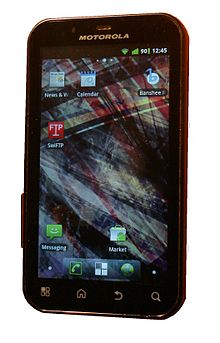 | |
| Manufacturer | Motorola Mobility |
|---|---|
| Type | Smartphone |
| First released | 3 November 2010 |
| Successor | Motorola Defy Plus Motorola Defy (2021) |
| Compatible networks | Quad band GSM with GPRS/EDGE (850/900/1800/1900 MHz in all regions) Dual band UMTS with HSPA+/HSUPA (850/1700/2100 MHz in the USA, 900/2100 MHz in Europe, and 850/2100 MHz in Australia, New Zealand and Thailand) |
| Form factor | Slate |
| Dimensions | 4.21 in (107 mm) H 2.32 in (59 mm) W 0.53 in (13 mm) D |
| Weight | 118.0 grams (4.16 oz) |
| Operating system | Android 2.1-update1, 2.2.1, 2.2.2, 2.3.4 (beta) with enhanced Motoblur; 4.0.3 Ice Cream Sandwich(CyanogenMod) & MIUI;[1] 4.1.2 ,4.2.1 Jelly Bean(CyanogenMod);[2] 4.4 KitKat(CyanogenMod)[3] |
| CPU | 800 MHz TI OMAP3610-800 (or OMAP3630-800) |
| GPU | PowerVR SGX 530 |
| Memory | 512 MB RAM |
| Storage | 2 GB, internal storage (approx. 1.2 GB available) |
| Removable storage | microSDHC supports up to 32 GB |
| Battery | 1,540 mAh internal rechargeable Li-ion (replaceable) |
| Rear camera | 5 megapixel (2,560 × 1,920) LED flash |
| Display | 3.7 in (94 mm) S-TFT FWVGA 854×480 px using Gorilla Glass |
| Data inputs | Capacitive touchscreen display |
| SAR | 1.52 W/kg (head) 1.53 W/kg (body) |
| Other | Built-in FM radio (requires headset/headphones cable to be plugged into the audio jack to function, as this cable serves as antenna) |
| References | [4][5] |
Preview warning: Page using Template:Infobox mobile phone with unknown parameter "carrier"
Preview warning: Page using Template:Infobox mobile phone with unknown parameter "media_formats"
The Motorola Defy (A8210/MB525) is an Android-based smartphone from Motorola. It filled a niche market segment, by being one of the few small, IP67 rated smartphones available at the time of its late 2010 release; it is water resistant, dust resistant, and has an impact-resistant screen.[6] An updated version of the original model, Defy+ (MB526) was released in 2011. Other variants were also released before a revival of the Defy name in 2021.
- ^ "ICS "CM9" Experimental Builds for the Defy!". XDA Developers. 18 November 2011. Retrieved 7 February 2012.
- ^ "JB CM10 build for Defy!". XDA Developers. Retrieved 10 June 2012.
- ^ "[Kitkat] AOSP/CM11 Android 4.4 for the Defy(+)". XDA Developers. Retrieved 9 June 2013.[permanent dead link]
- ^ "MOTODEV > Products > DEFY MB525 specifications". Motorola. Archived from the original on 7 March 2011. Retrieved 9 March 2011.
- ^ "Motorola DEFY - Full phone specifications". GSMArena. Retrieved 9 March 2011.
- ^ "Motorola DEFY". Clove Technology. Retrieved 9 March 2011.